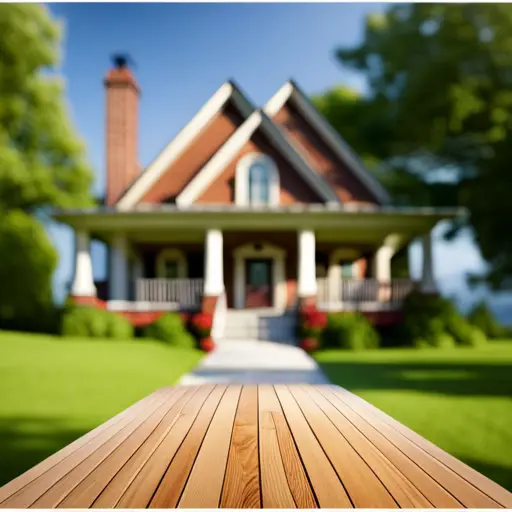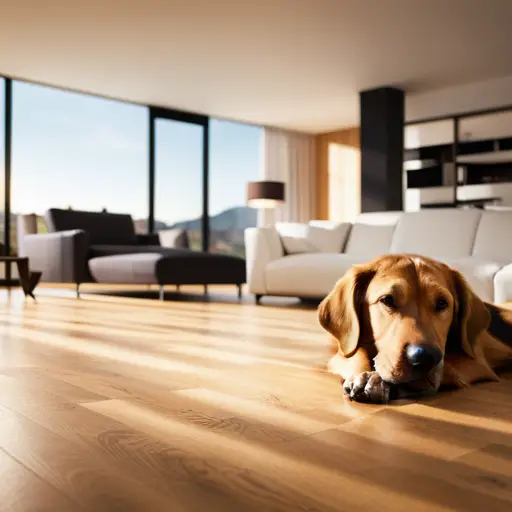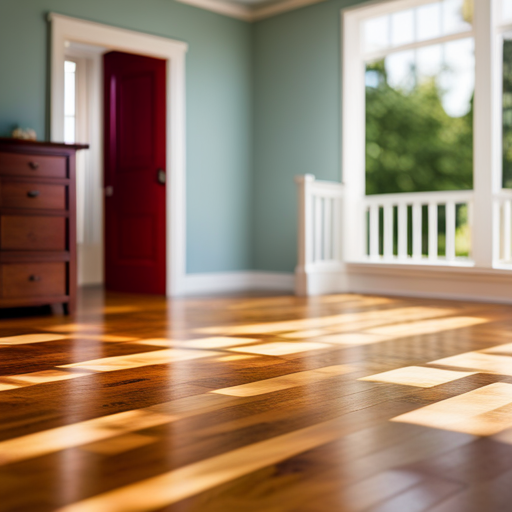The Benefits of Versatile Flooring in Multi-Use Properties

In the world of multi-use properties, the choice of flooring can either enhance or hinder the functionality and appeal of the space.
Versatile flooring options offer a unique juxtaposition of durability and flexibility, catering to diverse activities while ensuring easy maintenance and safety.
This article explores the myriad benefits of such flooring solutions, from their aesthetic appeal to their cost-effectiveness and environmental sustainability, making them a compelling choice for any multi-use property.
Enhanced Durability
Enhanced durability is a key attribute of versatile flooring in multi-use properties, ensuring long-term resilience to heavy foot traffic and varying environmental conditions. Impact resistance is a critical feature of such flooring, as it allows the surface to withstand the rigors of constant use without showing signs of wear and tear. This quality is especially advantageous in commercial and public spaces where the flooring is subjected to high levels of foot traffic and potential impacts from heavy objects.
Moreover, the longevity benefits of durable flooring cannot be overstated. By investing in flooring with enhanced durability, property owners can significantly reduce the frequency of repairs and replacements, leading to cost savings in the long run. The ability of durable flooring to maintain its quality and appearance over an extended period contributes to a more sustainable and economically viable solution for multi-use properties.
Additionally, the reduced need for frequent maintenance and replacements aligns with the growing emphasis on sustainable building practices, making durable flooring a practical choice for modern multi-use properties.
Flexibility for Diverse Activities
A key aspect of versatile flooring in multi-use properties is its ability to accommodate a wide range of activities, providing a flexible foundation for diverse uses.
Custom design and multipurpose spaces are becoming increasingly popular in commercial and residential settings. Versatile flooring options such as luxury vinyl tile (LVT) and engineered hardwood offer adaptable surfaces that can seamlessly transition from high-traffic areas to more specialized zones.
This adaptability is essential for activity diversity in multi-use properties, allowing spaces to be easily repurposed for different events and functions. Whether it’s transforming a conference area into an impromptu dance floor or converting a retail space into a yoga studio, the flexibility of versatile flooring ensures that the physical environment can keep up with the evolving needs of the occupants.
Additionally, these adaptable surfaces can be customized to create designated areas for specific activities, contributing to a cohesive and efficient use of space. By providing a foundation that can effortlessly support diverse activities, versatile flooring enhances the functionality and appeal of multi-use properties.
Easy Maintenance and Cleaning
The adaptability of versatile flooring in multi-use properties extends to easy maintenance and cleaning, allowing for efficient upkeep of the diverse activity areas. When it comes to maintaining such flooring, several time-saving strategies can be employed, making it easier for property owners to keep the space in top condition.
Some of the methods that can be utilized include:
- Regular sweeping and vacuuming to remove dirt and debris
- Using eco-friendly cleaning products to promote a healthier indoor environment
- Applying protective coatings to the flooring to reduce the need for frequent deep cleaning
- Implementing a proactive maintenance schedule to address any issues promptly and prevent extensive damage
By incorporating these practices, property managers can ensure that the flooring in multi-use properties remains in optimal condition with minimal effort.
Additionally, these maintenance and cleaning approaches contribute to a more sustainable and eco-friendly environment, aligning with modern requirements for responsible property management.
Improved Safety Features
Enhancing safety in multi-use properties is crucial for protecting occupants and reducing liability. Slip-resistant flooring surfaces can significantly minimize the risk of accidents, creating a safer environment for everyone.
Additionally, durable materials that withstand heavy use further contribute to the overall safety and longevity of the flooring in these versatile spaces.
Slip-Resistant Surfaces Reduce Accidents
Slip-resistant surfaces significantly enhance safety in multi-use properties by reducing the risk of accidents. This feature is crucial in spaces with varying activities, such as commercial buildings, schools, and healthcare facilities.
The implementation of slip-resistant flooring provides the following benefits:
-
Reduced Liability: By incorporating slip-resistant surfaces, property owners mitigate the risk of slip and fall accidents, reducing potential legal liabilities.
-
Enhanced Safety Precautions: Slip-resistant flooring contributes to a safer environment, especially in areas prone to moisture or spills, such as kitchens, bathrooms, and entrances.
-
Accident Prevention: The textured surface of slip-resistant flooring minimizes the likelihood of slips and falls, thereby preventing injuries and accidents.
-
Improved Public Perception: Multi-use properties with slip-resistant surfaces demonstrate a commitment to safety, enhancing their reputation and appeal to tenants, visitors, and customers.
Durable Materials Withstand Heavy Use
Durable materials withstanding heavy use in multi-use properties enhance safety features by providing long-lasting reliability and resilience in high-traffic areas. The longevity benefits of these materials ensure that the flooring maintains its structural integrity and safety features over an extended period.
This is particularly important in spaces where there is a high volume of foot traffic, equipment movement, or frequent use, as it reduces the need for frequent replacements or repairs, thereby minimizing potential hazards and safety risks.
Usage considerations play a crucial role in selecting these materials, as they need to withstand heavy loads, frequent movement, and potential impacts without compromising safety.
Aesthetically Appealing Design Options
Selecting an appropriate flooring option for multi-use properties involves considering aesthetically appealing design options that complement various functional spaces. Design flexibility and customizable options are essential factors to consider when aiming to create a visually pleasing environment that meets the diverse needs of a multi-use property. Here are some key elements to keep in mind:
-
Color Variety: Flooring options that offer a wide range of colors enable property owners to match the design with the overall aesthetic of different areas within the property.
-
Texture Variations: Customizable textures allow for the creation of distinct atmospheres within different spaces, catering to the specific requirements of each area while maintaining a cohesive design throughout the property.
-
Pattern Choices: From classic to contemporary patterns, having customizable options in flooring enables property owners to create visually appealing designs that align with the intended atmosphere of each space.
-
Material Combinations: The ability to combine different materials, such as wood and stone, provides a unique opportunity to craft visually stunning and functional flooring designs that enhance the overall appeal of the property.
Cost-Effectiveness and Long-Term Savings
When considering flooring options for multi-use properties, it is important to prioritize cost-effectiveness and long-term savings through strategic material selection and maintenance planning. Investing in versatile flooring that offers durability and low maintenance can lead to significant financial benefits over time. Here is a comparison to highlight the cost-effective aspect of versatile flooring options:
| Flooring Type | Initial Cost | Maintenance Cost | Longevity |
|---|---|---|---|
| Versatile Flooring | Moderate | Low | High |
| Traditional Carpet | Low | Moderate | Moderate |
| Hardwood Flooring | High | Moderate | High |
| Tiles | Moderate | Low | High |
As demonstrated in the table, while versatile flooring may have a slightly higher initial cost compared to traditional carpet, it offers lower maintenance costs and longer longevity, making it a cost-effective investment in the long run. On the other hand, hardwood flooring, despite its high initial cost, also provides high longevity, but with moderate maintenance costs. Tiles, similar to versatile flooring, have moderate initial costs and low maintenance costs, offering high longevity. Therefore, the financial benefits of choosing versatile flooring in multi-use properties are evident, making it a prudent long-term investment.
Environmental Sustainability
Considering the long-term financial implications, an important aspect of flooring selection for multi-use properties is the environmental sustainability of the chosen materials. With the increasing focus on green building and sustainable practices, the use of eco-friendly materials for flooring can significantly contribute to the overall environmental impact of a property.
When it comes to multi-use properties, the selection of environmentally sustainable flooring materials is even more crucial due to the diverse range of activities and foot traffic they accommodate.
Here are some key considerations for environmental sustainability in flooring choices:
- Use of recycled materials such as reclaimed wood or recycled rubber flooring
- Installation of flooring with low volatile organic compound (VOC) emissions to maintain indoor air quality
- Opting for renewable materials like bamboo or cork that have minimal environmental impact
- Choosing flooring options that are durable and require minimal maintenance to reduce resource consumption
Incorporating these eco-friendly practices into the selection and installation of flooring aligns with the broader sustainability goals of multi-use properties and promotes a healthier environment for occupants and visitors.
Frequently Asked Questions
Can Versatile Flooring Be Installed in Outdoor Areas as Well as Indoor Spaces?
Yes, versatile flooring can be installed in outdoor areas as well as indoor spaces. When considering outdoor installation, it’s important to choose materials designed for exterior use and follow maintenance tips to ensure longevity and durability.
What Are the Best Flooring Options for High-Traffic Areas in Multi-Use Properties?
The best flooring options for high-traffic areas in multi-use properties must prioritize durability, ease of maintenance, and safety. Differentiating between indoor and outdoor installation requirements is crucial, making versatile flooring a compelling choice for such spaces.
Are There Specific Cleaning Products or Techniques That Should Be Used to Maintain Versatile Flooring?
When it comes to maintaining versatile flooring, it’s essential to use appropriate cleaning products and maintenance techniques. This ensures the longevity and aesthetic appeal of the flooring, while also preserving its functionality in multi-use properties.
How Does Versatile Flooring Contribute to Improved Safety in Multi-Use Properties?
Improved traction and slip-resistant surfaces provided by versatile flooring contribute significantly to enhanced safety in multi-use properties. These features reduce the risk of slips and falls, creating a secure environment for occupants and visitors.
What Are the Environmental Benefits of Choosing Versatile Flooring Over Traditional Options?
Choosing versatile flooring over traditional options offers environmental benefits such as reducing waste and utilizing sustainable materials. This choice promotes eco-friendly practices and contributes to a more sustainable and responsible approach to flooring solutions.
Conclusion
In conclusion, the advantages of versatile flooring in multi-use properties are substantial. Its enhanced durability, flexibility for diverse activities, easy maintenance, and improved safety features make it a valuable investment.
Additionally, the aesthetically appealing design options, cost-effectiveness, and environmental sustainability of versatile flooring further contribute to its appeal for multi-use properties.
Its ability to accommodate various activities and its long-term savings make it an ideal choice for multi-use properties.
In today’s rapidly changing environment, versatile flooring is an essential and practical solution for maximizing the functionality and aesthetic appeal of multi-use spaces.

Rubin Everest, a seasoned expert in the world of flooring, brings a wealth of knowledge and passion to the surface. As the mind behind ebbow.com, Rubin is dedicated to sharing insights on the latest trends, innovative solutions, and expert advice in the realm of flooring. Whether you’re seeking practical tips for installation or design inspiration, Rubin Everest is your go-to source for all things flooring-related, making your journey to the perfect floor an informed and enjoyable experience.





